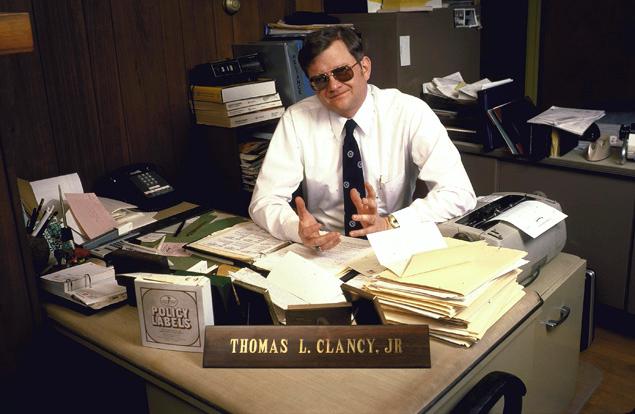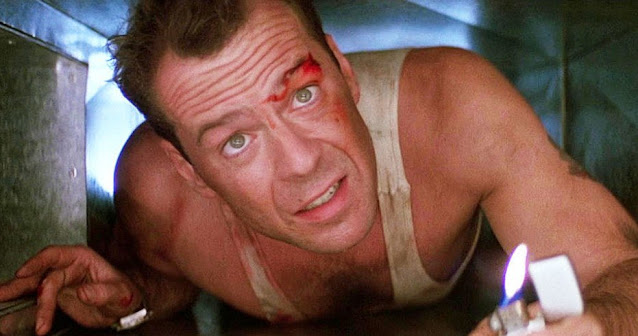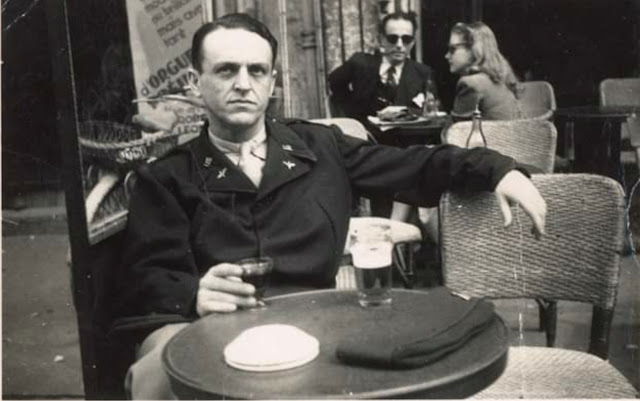Tom Clancy on Writing "The Hunt for Red October"
Tom Clancy attributes his success as a novelist to equal parts dogged persistence and deep research. “You learn to write the same way you learn to play golf,” Clancy said. “You do it, and keep doing it until you get it right. A lot of people think something mystical happens to you, that maybe the muse kisses you on the ear. But writing isn’t divinely inspired – it’s hard work.”
 |
| Author Tom Clancy in his insurance office in 1985, shortly after publishing his first novel, The Hunt for Red October |
When Clancy’s first novel, The Hunt for Red October, was published, one former Soviet-watching intelligence officer conjectured that Clancy must have had inside information from U.S. intelligence personnel who intercept Soviet communications. “That’s a lot of crap,” Clancy replied. In fact, his basic sources were hundreds of books with dry titles like The World’s Missile Systems, Guide to the Soviet Navy and Combat Fleets of the World. Clancy also learned a great deal from a war game called Harpoon, which the Navy used as an instruction manual for ROTC cadets.
However, Clancy claims that most of his research involves talking endlessly to the types of people he wants to write about. For Red October, he interviewed former submariners who were operating the Baltimore Gas & Electric nuclear power plant near his home in Huntingtown, MD. At his publisher’s request, the finished manuscript of Red October was read by two submarine officers, who found only a few mistakes. For example, Clancy had put valves on the bottom of the ballast tanks, rather than the top.
Clancy said that the only real blueprint he used when writing Red October was a time-motion chart which kept track of where each character was as the plot unfolded. “Fundamentally, I think of myself as a storyteller, not a writer,” Clancy said. “I think about the characters I’ve created and then I sit down and start typing and see what they will do. There’s a lot of subconscious thought that goes on. It amazes me to find out, a few chapters later, why I put someone in a certain place when I did. It’s spooky. It can be agonizing, too, but god, it can be fun. When it goes right, this can be so much fun that it’s just not work.”
 |
| Alec Baldwin as 'Jack Ryan' in The Hunt for Red October |
 |
| Harrison Ford as 'Jack Ryan' in Patriot Games |
“What happened to me was pure dumb luck – I’m not the new Hemingway,” Clancy said. “Of course, fortune does favor the brave. In battle, you forgive a man anything except an unwillingness to take risks. Sometimes you have to put it on the line. What I did was take time away from how I earned my living. My wife gave me hell – ‘Why are you doing this?’ – but she doesn’t complain anymore. I wanted to see my name on the cover of a book. If your name is in the Library of Congress, you’re immortal.”
In 1988, Wanda Clancy wryly recalled the days before her husband became a bestselling author. “He was writing at home every weekend. I told him he should go back to selling insurance – I’ve eaten those words a few times. But once I read the book, I changed my mind. Tom said he’d be happy if it would sell 5,000 copies, but I told him not to worry – it’d sell a lot more than that.”
After The Hunt for Red October was published, Clancy became the darling of the Navy, which fell over itself praising the book’s authenticity. Enlisted men often told Clancy that his characters were just like people they’d worked with. “They treat me like some kind of arriving admiral,” Clancy admitted sheepishly. “I tell them that’s not right, that they are the real heroes. All I do is write about what they do, and that’s certainly not the same thing as doing it.”
Clancy’s popularity with the military brass opened the way for him to tour nuclear subs, examine new aircraft carriers, spend a week aboard a Navy frigate, drive an M-1 tank and shoot anti-tank missiles at the Aberdeen Proving Ground. Clancy spoke about the book at the Naval Academy and even addressed the CIA at their headquarters in Langley, VA about how he did his research.
For Tom Clancy, celebrity wasn’t a burden. “It’s like being cured of leprosy,” he said. “Before, it was always, ‘Oh, no, here comes Clancy, that insurance agent.’ Now it’s, ‘Oh, here comes Tom Clancy, bestselling author.’ But I’m still the same basic middle-class slob.”
Patricia Blake, “One of Their Subs Is Missing,” Time, 3/4/85
Robert Lekachman, “Virtuous Men and Perfect Weapons,” New York Times, 7/27/86
Edwin McDowell, “Author of ‘Red October’ Stirs Up a ‘Red Storm,’” New York Times, 8/12/86
Michelle M. Murphy, “Author’s Treasure Hunt Ends in October,” Chicago Sun-Times, 8/28/86
Art Levine, “The Pentagon’s Unlikely Hero: With Uncanny Accuracy, Author Tom Clancy Details Secret U.S. Weaponry,” U.S. News & World Report, 9/15/86
Patrick Anderson, “King of the Techno-Thriller,” New York Times, 5/1/88




Comments